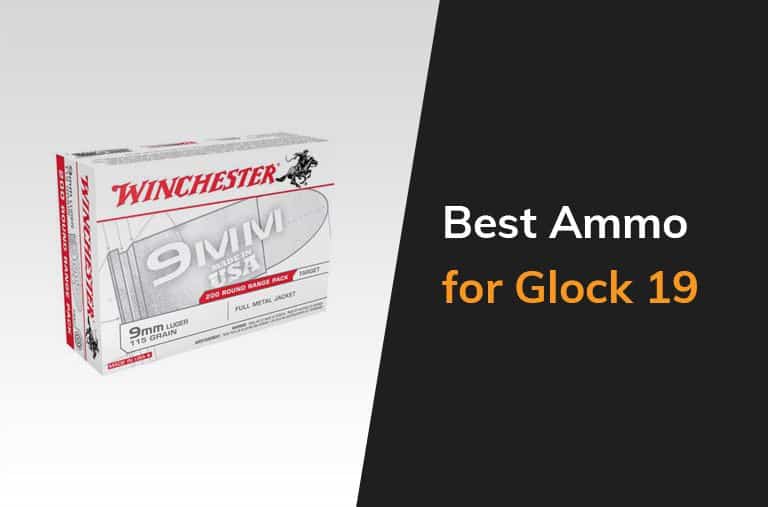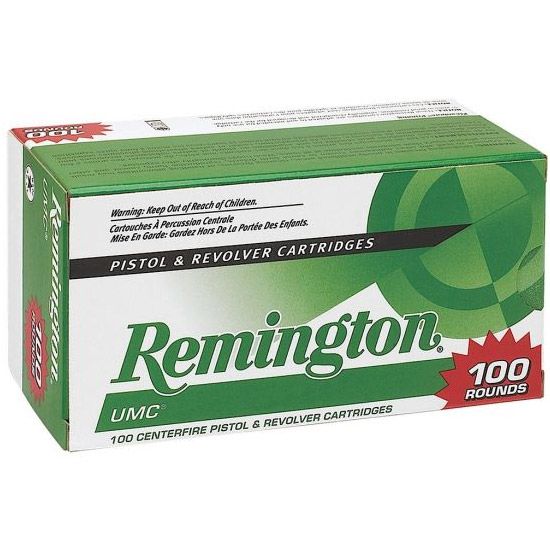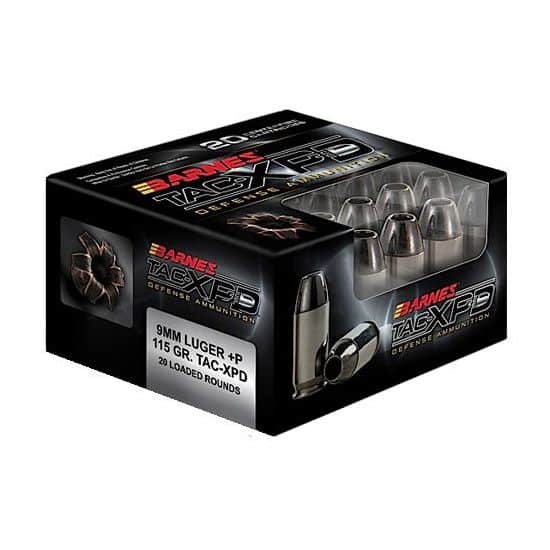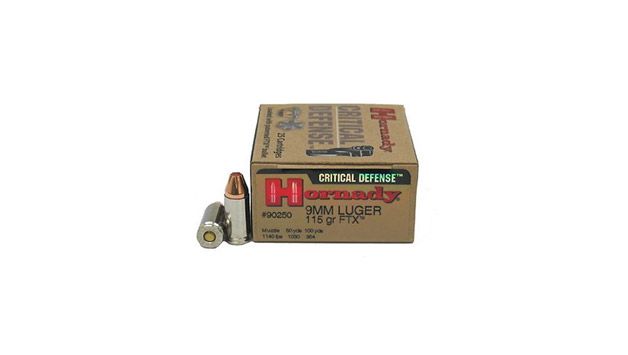At a Glance: The Best 9mm Ammo For Glock
- OUR TOP PICK: Winchester USA 9mm FMJ Ammo
- TOP RATED: Federal Premium Punch Defense 9mm Ammo
- BEST BUDGET OPTION: Remington UMC 9mm Ammo
Comparison of The Best 9mm Ammo For Glock
| PRODUCT | DETAILS | ||
|---|---|---|---|
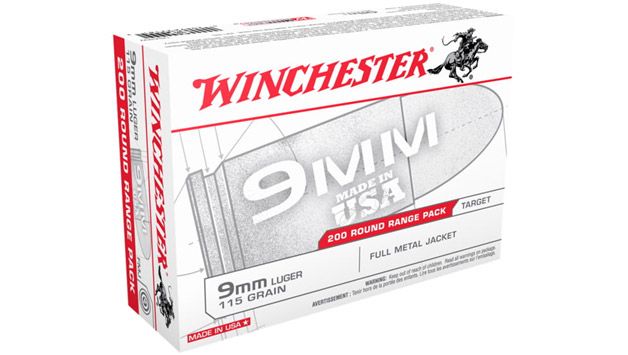
Our Top Pick
|
Winchester USA 9mm FMJ Ammo |
|
View Latest Price |
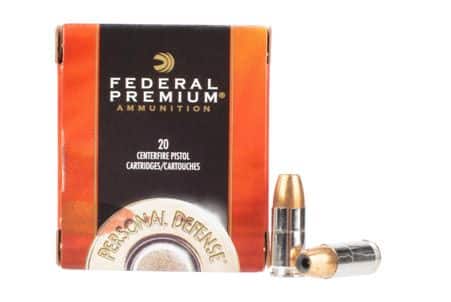
Our Top Pick
|
Federal Premium Punch Defense 9mm Ammo |
|
View Latest Price |
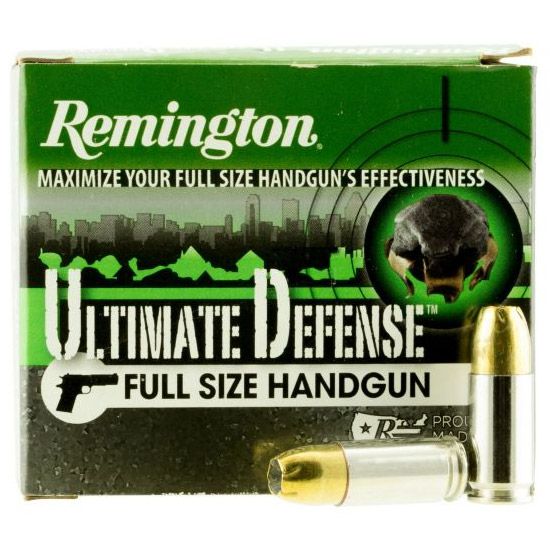
Our Top Pick
|
Remington Ultimate Defense 9mm Ammo |
|
View Latest Price |
The Glock 19 is a popular handgun, and for good reasons. It’s compact, easy to shoot, and highly reliable. Owning the right Glock 9mm handgun is only half the battle—without the correct ammunition, your Glock may not reach its full potential. Here’s how to choose the best 9mm ammo for your Glock, along with four of the best target and defensive cartridges available today.
Our Guide to the Best 9mm Ammo for Glock
I spent weeks trying to find the best 9mm ammo for my Glock. Eventually, it boiled down to one fundamental question: What do I use my Glock 19 for? It’ll be easy to select the right ammunition once you answer this question. Here, we reviewed six popular cartridges to help you find the best 9mm ammo for your handgun.
Winchester USA 9mm FMJ Ammo
Winchester’s FMJ (full metal jacket) 9mm ammunition is America’s bread-and-butter general-purpose ammo. If you’ve been shooting for a while, chances are you have a classic grey box of Winchester hanging around somewhere.
Features
- Bullet Style: Full Metal Jacket (FMJ)
- Bullet Weight (Grains): 115
- Cartridge: 9 mm Luger
- Muzzle Energy: 362
- Muzzle Velocity (feet per second): 1190
Winchester 9mm FMJ: A Dependable and Affordable Option for the Range
Winchester’s 9mm FMJ features a fully-jacketed (copper covered) 115-grain lead round with a solid point and a brass casing. Many shooters prefer brass casings, as the softer metal makes malfunctions less likely. Additionally, Winchester’s 9mm FMJ isn’t steel-core, so it’s safe to shoot at any shooting range.
The Tradeoffs of Bullet Weight and Velocity in Winchester’s 9mm FMJ
Winchester’s 115-grain bullet is on the lighter side for 9mm rounds, which usually range from 115 to 147 grains. Like most things, bullet weight is a tradeoff. What you lose in hitting power, you gain in velocity. Remember, it’s not necessarily how hard you hit the target—it’s how effective the bullet is when it hits the target.
This round exits the barrel with a muzzle velocity of 1,090 feet per second, making it fast, accurate, and dependable. Its relatively low bullet weight reduces recoil, so most shooters can handle it with ease.
Reliability and Safety of Winchester 9mm Full Metal Jacket Ammunition
Reliability is a significant selling point for Winchester full metal jacket 9mm ammo. That’s not to say that the Glock 19 itself isn’t reliable—Glock is legendary for dependability. But there’s no room for malfunction when your life (and your confidence in your weapon) depends on it. Full metal jacket rounds are less likely to deform during feeding. They also offer enhanced penetration.
However, penetration isn’t always advantageous in defensive situations. Full metal jacket rounds sometimes penetrate the target and the wall behind them, which risks injuring bystanders.
When to Use Winchester USA 9mm Ammunition
When you combine Winchester’s high manufacturing quality with the positive characteristics of this round, you get a reliable go-to cartridge for typical shooting activities and (if necessary) defensive situations. And while it’s not the most effective self-defense or hunting round, Winchester USA 9mm ammunition is some of the best 9mm ammo for the range.
Pros
- Low recoil
- Reliable feeding
- Brass case
- Superior penetration
Cons
- Less effective in self-defense (compared to hollow points)
- Potential over-penetration in closed environments
- Copper fouling from the jacket can be challenging to clean
- Residents in CA, DC, IL, MA, NY, CT, and NJ may have additional restrictions
Federal Premium Punch Defense 9mm Ammo
Federal is another well-known ammunition manufacturer with a reputation for American-made quality. Their Punch Defense combines the reliability of full-metal-jacket rounds with the stopping power of hollow points.
The Benefits of Federal Premium Punch Hollow Point Ammunition
Hollow point rounds are ideal for defensive situations. This heavy-hitting 124-grain jacketed round offers superior stopping power to solid-nose rounds. As seen on the box, these Federal hollow point 9mm rounds expand when they hit the target, effectively mimicking the effects of much larger calibers.
Ballistic Superiority: Comparing Federal Premium Punch to Other 9mm Rounds
Despite its heavier 124-grain bullet, Federal Premium Punch 9mm has a velocity of 1,150 feet per second. This is higher than Winchester FMJ, making Federal Premium Punch a superior all-around defensive cartridge. It hits hard, fast, and wide, thanks to an expanding hollow point.
This round features a copper jacket, which is the most common kind of plating used for jacketed rounds. Copper is reliable and doesn’t damage the barrel, but it can lead to unsightly green copper fouling that’s difficult to clean.
Generally speaking, hollow point ammunition feeds somewhat less reliably in automatic pistols. Federal makes up for this disparity using nickel-plated brass cases, which reduces friction and encourages smooth chambering and ejection.
Is Federal Premium Punch Right for You?
I would describe Federal Premium Punch as an excellent introduction to ‘premium’ defensive ammunition. This isn’t your plinking cartridge—it’s the cartridge you carry every day and practice with carefully.
Federal Premium Punch is some of the best 9mm self-defense ammo available today. It’s ballistically superior to any solid-nose round for defense. It offers both higher weight and velocity than the average 9mm cartridge. Increased recoil could be a problem for some shooters, but the added effectiveness of the round could make all the difference in a defensive situation.
Pros
- Hard-hitting 124-grain bullet
- Ballistically superior hollow point for defense
- Nickel-plated cases increase reliability
- Higher than average velocity
Cons
- Hollowpoint ammo may feed less reliably overall
- Heavier recoil than some 9mm cartridges
- Nickel-plated cases are brittle and may be more difficult to reload
- Copper jacket increases copper fouling, which is unsightly and difficult to clean
Remington Ultimate Defense 9mm Ammo
Here we have Remington’s take on a high-end defensive hollow point. Remington Ultimate Defense 9mm ammunition is designed specifically for home and personal defense. This premium 9mm cartridge offers superior accuracy and higher-quality materials than the average brand.
Features
- Bullet Style: Brass Jacketed Hollow Point
- Bullet Weight (Grains): 124
- Cartridge: 9 mm Luger
Brass Jackets vs. Copper Jackets
Like Federal Premium Punch Defense, Remington Ultimate Defense features a nickel-plated brass casing for better feeding. But unlike Federal, Remington opted for a brass jacket instead of copper. Brass jackets won’t foul the barrel as quickly as copper, which increases long-term accuracy and reduces cleaning time.
The Unique Design of Remington Ultimate Defense’s Heavy 124-Grain Hollowpoint Bullet
Remington’s heavy 124-grain hollowpoint bullet is uniquely conical and narrow. In other words, the bullet itself looks ‘pointy’ and thin. But there’s a good reason for this—the tapered round reduces friction and increases accuracy, which is a big plus for precision-grade shooting.
Balancing Velocity and Recoil
Remington Ultimate Defense falls on the high end of the velocity spectrum at 1,130 feet per second but falls short of Federal Premium Defense. This could be an advantage, as lower velocity can slightly reduce recoil.
As we mentioned before, hollow point rounds are superior to solid-nose in defensive situations. Remington’s round expands upon impact with a target. This simultaneously increases effectiveness and reduces the chance of a stray bullet going through a wall and threatening bystanders.
The Advantages of Using Remington Ultimate Defense for Self-Defense
Overall, Remington Ultimate Defense is an excellent self-defense cartridge offering superior accuracy and easy cleaning. It retains the hard-hitting qualities of other popular hollowpoints while simultaneously reducing maintenance requirements. If you’re obsessed with accuracy, Remington Ultimate Defense 9mm is an excellent choice for defending your home and business.
Pros
- Heavy 124-grain bullet
- Unique bullet shape for superior accuracy
- Brass jacket reduces barrel fouling
- Higher than average velocity
- Nickel-plated case for reliability
Cons
- Recoil may discourage inexperienced shooters
- Velocity is slightly lower than some competing brands
Remington UMC 9mm Ammo
Here’s another Remington product designed with target shooters in mind. Remington UMC 9mm is a solid-nose full metal jacket cartridge. It’s made right here in the United States and backed by Remington’s reputation for high-quality materials and manufacturing.
Features
- Bullet Style: Jacketed Hollow Point
- Bullet Weight (Grains): 115
- Cartridge: 9 mm Luger
Remington UMC is comparable to Winchester’s FMJ 9mm solid-nose ammunition in quality and overall utility, but the round differs in a few key areas. Remington UMC 9mm has a velocity of 1,145 feet per second, which is higher than the competing Winchester cartridge. However, both products share a 115-grain copper-jacketed lead bullet.
The Advantages of Copper Jacketing in Remington UMC 9mm Ammunition
Copper jacketing offers superior performance to unjacketed lead rounds. It also increases reliability, as copper prevents the round from deforming during feeding. Remember, copper jackets increase barrel fouling over time and complicate cleaning.
Remington UMC vs. Winchester: Comparing Velocity and Overall Utility
Remington UMC ammo is ideal for people who spend more than a few minutes at the range. This ammunition is harder-hitting than the comparable Winchester round, but it also has increased recoil. But the difference is marginal and shouldn’t be an issue for experienced shooters.
Stocking Up on Remington UMC: The Ideal General Purpose Round for the Range
Remington UMC 9mm is an excellent cartridge to stock up on. And although Remington Ultimate Defense is a better option for self-defense, UMC will certainly work if the need arises. This ammunition is a premium ‘general purpose’ round and a fantastic choice for stocking-up.
Many shooters purchase hundreds or thousands of these rounds at a time. Remington UMC 9mm is a wise choice for an all-day trip to the range or when training with your Glock 19. This ammunition is ideal if you need a hard-hitting and reliable round for practice. Throw a couple of boxes in the safe and a few more in your range bag, and you can plink all day without trouble. But if you’re brand new to shooting, you may want to consider Winchester instead for lighter recoil.
Pros
- Excellent reliability
- Higher velocity than competitors
- High-quality brass case
- Copper jacket increases accuracy
Cons
- Heavier recoil than Winchester solid-nose 9mm
- Copper jacket can cause fouling
Barnes TAC-XPD Personal and Home Defense 9mm +P Ammo
The Ideal Defensive Round for Everyday Carry
Barnes TAC-XPD 9mm +P ammunition is a uniquely engineered defensive round that’s ideal for everyday carry in a Glock 19. This hollow point cartridge is on the high-end of defensive ammo, and it’s ideal for shooters who want the latest breakthroughs in ammunition design. If you’re looking for a high-caliber punch in a small cartridge, then Barnes TAC-XPD +P may be the ammo for you.
Barnes TAC-XPD ranks among the best 9mm ammo for defense. It’s classified as a +P round, meaning it’s more potent than a standard 9mm cartridge. But how does +P designation translate to the real world? In this case, the light 115-grain bullet exits the barrel at a higher pressure and achieves a respectable velocity of 1,125 feet per second.
Advantages of an All-Copper Hollow Point in Barnes TAC-XPD +P Ammunition
The bullet itself is all copper and features an unusually deep hollowpoint cavity. Through in-house testing, Barnes demonstrated the ballistic superiority of this design and claims they achieved the best and most consistent performance in the market.
There are real practical advantages to the all-copper hollow point round, especially at higher (+P) pressures. The deeper hollow cavity allows for increased expansion, and the added strength of the copper holds it all together. Additionally, all-copper rounds are acceptable in areas where environmental laws prohibit lead ammunition.
But before shooting with +P ammunition, be sure to check if it’s safe to use in your gun. Some older firearms aren’t designed for the increased working pressures of +P ammo.
Barnes TAC-XPD ammunition features everything you’d expect from a premium defensive round, including a nickel-plated casing for reduced friction and increased reliability. Accuracy is excellent, and the round reports a modest drop of 1 inch at 50 yards. Interestingly, the Barnes 9mm +P bullet experiences less drop than a comparable .45 ACP +P round.
A Premium Choice for Glock Owners
Overall, I’d recommend the Barnes TAC-XPD cartridge for Glock owners who carry daily and expect maximum stopping power. Whatever disadvantages hollow point ammunition may have are likely outweighed by the precise engineering of this defensive round.
Pros
- All-copper bullet
- Superior expansion and ballistic performance
- +P round offers extra power
- Nickel-plated casing increases reliability
- Legal where lead ammunition is prohibited
Cons
- Not ideal for plinking, as some ranges prohibit high-penetration ammo
- Some shooters consider +P ammunition to be ‘overkill’
- Conversely, some shooters report disappointing power compared to other +P rounds
Hornady Critical Defense 9mm Ammo
An Advanced Solution to Expansion Problems
Hornady Critical Defense ammo is a popular high-end defensive 9mm hollow point round. This company has a reputation for experimental ammo designs, and they produce premium self-defense and hunting ammo. The patented Hornady FTX bullet has a few tricks up its sleeve and offers numerous advantages to typical 9mm rounds.
Hornady’s Critical Defense 9mm cartridge features a red synthetic inlay in its hollow cavity, immediately distinguishing it from the other products on our list. At first, the idea of sending a bullet with a plastic insert down a hot gun barrel may seem absurd, but it’s actually part of Hornady’s FTX bullet system.
The FTX system ‘flex tip’ is Hornady’s solution to the problem of expansion. The red rubber-like insert controls bullet deformation and helps the round fray out evenly after impacting a target. The plugged nose also stabilizes trajectory when the bullet flies through the air. This effectively eliminates the (obvious) accuracy problems caused by drilling a hole in the tip of a bullet.
Proprietary Powder Blend: Reduced Recoil and Muzzle Flash in Hornady Critical Defense 9mm
Hornady didn’t stop there. In addition to an advanced bullet design, the company also utilized a proprietary powder blend that reduces recoil and muzzle flash. However, this seemingly perfect cartridge has some notable drawbacks.
Disadvantages of Hornady Critical Defense 9mm Ammunition
Hornady Critical Defense 9mm is the fastest and heaviest ammunition on our list. It has a bullet weight of 115 grains and a velocity of 1,125 feet per second. In the Glock 19, the recoil difference between this round and most standard 9mm ammo is noticeable. It’s much ‘snappier’ and louder than the average cartridge, which can be an issue for some shooters.
Is Hornady Critical Defense 9mm Right for You? Ideal Uses and Final Thoughts
Overall, the Hornady Critical Defense 9mm cartridge is a big winner for hunting and defense. It’s ideal for everyday carry, vehicle carry, and home defense.
However, it’s not the best general-purpose or target practice round, as the added recoil and overwhelming ‘crack’ can be fatiguing after just a few magazines. Some shooters describe shooting this powerful round as “just a bit too much” for regular plinking.
Pros
- FTX bullet provides solid-tip accuracy
- Even bullet expansion
- In-house powder reduces recoil and muzzle flash
- Nickel-plated casing increases reliability
Cons
- Recoil still heavy despite improved powder
- It’s powerful all-around ammo and may be overwhelming for some shooters
Best 9mm Ammo: Top Picks for Gun Enthusiasts and First-Time Gun Owners
Determining the most suitable 9mm ammunition for your handgun can be a daunting proposition, regardless if you are an experienced shooter or just starting out. With so many competing brands all promising accuracy, reliability and stopping power – it’s hard to know what will truly provide optimal performance. In this article we evaluate six of the premier 9mm ammo products on the market today in terms of velocity, accuracy, penetration and expansion; while at same time also highlighting their unique features as well as any drawbacks they may have. By comparing each product with these vital criteria through our reviews section below – we’ll equip you with everything necessary to make an informed decision when selecting your next round!
Top Pick #1: Winchester USA 9mm FMJ Ammo
Winchester USA 9mm FMJ Ammo is the perfect solution for all your range-shooting needs. From law enforcement to target shooters, this ammunition is reliable and dependable, with a 115 grain full metal jacket bullet that has an incredible muzzle velocity of 1190 feet per second and a muzzle energy of 362 foot pounds. With its boxer primed brass casings, you can enjoy easy reloads while also benefiting from superior corrosion resistance – making it the ideal choice for training or recreational plinking. However, the limited expansion capabilities of the FMJ bullet design make it unsuitable for personal defense or home defense situations.
Comparing it to the others
When contrasted to its counterparts, Winchester USA 9mm FMJ Ammo is an ideal selection for target training and recreational shooting. Furthermore, as the ammo is both inexpensive and corrosion resistant despite its limited expansion features; law enforcement agencies favor this choice for competitive shooters. Nonetheless, one should think twice about using it in personal defense scenarios due to its poor capabilities for expansion.
Benefits and Drawbacks
The Winchester USA 9mm FMJ Ammo is a dependable choice, with an average group size of 1.5 inches at 25 yards. Though it is budget-friendly and costs between $0.20 to $0.24 per round, its full metal jacket bullet design makes it less reliable in self defense situations due to limited expansion capabilities when compared to other options on the market today.
What sets it apart?
The Winchester USA 9mm FMJ Ammo stands out from the crowd thanks to its affordability, reliability and corrosion resistance. This ammunition is ideal for those who prioritize precision accuracy, reliable loading and ejection of their 9mm handgun while training or practicing at the range; making it an excellent choice.
Top Pick #2: Federal Premium Punch Defense 9mm Ammo
If you need reliable stopping power in a self-defense situation, Federal Premium Punch Defense 9mm Ammo is an optimal option. The 124-grain jacketed hollow point (JHP) bullet has a muzzle velocity of 1100 feet per second and 339-foot pounds of muzzle energy – ensuring expansion upon impact for deep penetration and maximum damage to the target. Tested against FBI standards for terminal performance, this ammunition excels at providing safety not only to law enforcement officers but also civilians.
This ammo stands out due to its corrosion-resistant nickel-plated brass casing, granting smooth feeding and ejection from any handgun. Nonetheless, the cost of this ammunition may be prohibitive for range training or target practice shooting sessions.
Comparing it to the others
This ammunition is an excellent option for personal defense situations, with a 124-grain HST JHP bullet having a muzzle velocity of 1150 feet per second and a muzzle energy of 364-foot pounds. The ammunition is known for its consistent expansion and deep penetration, making it a top choice for law enforcement agencies and civilians. However, compared to other personal defense options, the ammunition can be relatively expensive.
Benefits and Drawbacks
When safety is your number one priority, Federal Premium Punch Defense 9mm Ammo is the ideal choice for you. This ammunition provides reliable expansion and deep penetration through ballistic gel tests with an average penetration depth of 16 inches. Despite its premium quality, this ammo’s cost per round ranges from $0.70 to $1.20 – a small price to pay for peace-of-mind in defending yourself and those around you!
What sets it apart?
The Federal Premium Punch Defense 9mm Ammo is renowned for its impressive stopping power, reliable expansion, and penetrating capability – making it an optimal selection for personal self-defense. What really sets this ammunition apart from the rest is its dependable performance and deep penetration rate. This ammo ensures that you will be fully protected in any situation.
Top Pick #3: Remington Ultimate Defense 9mm Ammo
If you’re looking for the best ammo to protect yourself in a personal defense situation, look no further than Remington Ultimate Defense 9mm Ammo. It has a muzzle velocity of 1150 feet per second and 364-foot pounds of energy behind every 124-grain brass-jacketed hollow point (BJHP) bullet. The BJHP design guarantees top performance when it comes to expansion and penetration, effectively stopping an assailant with one shot. As soon as the hollow point strike its target, it expands creating even more damage due to increased wound channel size and kinetic energy transferal.
One unique feature of the Remington Ultimate Defense 9mm Ammo is its versatility to perform well in different types of handguns. It works well in compact handguns such as Glock pistols and full-size semi-automatic pistols. However, its cost is slightly higher than other personal defense options.
Comparing it to the others
This ammunition is another excellent option for personal defense situations, with a muzzle velocity of 1125 feet per second and a muzzle energy of 345-foot pounds. The 124-grain BJHP bullet ensures reliable expansion and penetration, making it a popular choice for law enforcement agencies and civilians alike. It is also known for its consistent performance and accuracy. However, the ammunition can be relatively expensive compared to other personal defense options.
Benefits and Drawbacks
The Remington Ultimate Defense 9mm Ammo is an excellent option for personal defense situations, with an average penetration depth of 14 inches in ballistic gel tests. The ammunition’s BJHP bullet design ensures reliable expansion and penetration, making it a top choice for stopping an attacker. Its only drawback is that it can be relatively expensive, with a price range of $0.70 to $1.00 per round.
What sets it apart?
The Remington Ultimate Defense 9mm Ammo is known for its reliable expansion and penetration, versatility to work with different types of handguns, and consistent performance and accuracy. The ammunition is a great choice for those who prioritize their safety and are willing to invest in high-quality ammunition for personal defense.
Barnes TAC-XPD Personal and Home Defense 9mm +P Ammo
For personal defense situations, the Barnes TAC-XPD Personal and Home Defense 9mm +P Ammo is another excellent choice. With a 115-grain copper-jacketed hollow point (CJHP) bullet, this ammunition delivers a muzzle velocity of 1125 feet per second and a muzzle energy of 329-foot pounds. The CJHP bullet design provides reliable expansion and deep penetration to stop an attacker. This ammo is well-known for its accuracy and consistency, making it a top choice for both law enforcement officers and civilians.
The Barnes TAC-XPD 9mm Ammo stands apart from other personal defense options with its unique all-copper bullet design. This ensures deep penetration and maximum energy transfer to the target, uninterrupted by any jacket separation. Moreover, low-flash powder in this ammo helps you maintain sight picture despite rapid fire shots – reducing muzzle flash and recoil for good measure! The only caveat is that it might be pricier than what most are used to; but trust us when we say the robust performance of this ammunition makes up for it tenfold. In addition, this ammunition is +P rated, which suggests that it carries higher pressure and velocity than the normal 9mm ammo. It’s important to remember though: only firearms explicitly manufactured for +P ammo should be utilized with these bullets.
Comparing it to the others
This ammunition is a reliable choice for personal defense situations, thanks to its all-copper bullet design, reliable expansion, and deep penetration. The 115-grain CJHP bullet offers a muzzle velocity of 1125 feet per second and a muzzle energy of 329-foot pounds. The ammunition is also accurate and consistent, making it a popular choice among both law enforcement and civilians. However, it can be more expensive than other personal defense options.
Benefits and Drawbacks
The Barnes TAC-XPD Personal and Home Defense 9mm +P Ammo is an excellent choice for protecting yourself in potentially dangerous situations. With its muzzle velocity at 1125 feet per second and 329 foot pounds of energy, you know it will be powerful enough to penetrate deeply with the help of its all-copper bullet design that promises reliable expansion and a penetration depth averaging 12 inches as verified by ballistic gel tests. Though more costly than others on the market, this ammo comes at prices ranging from $0.90 – $1.50 a round – worth every penny!
What sets it apart?
The Barnes TAC-XPD Personal and Home Defense 9mm +P Ammo stands out for its all-copper bullet design, which delivers reliable expansion and deep penetration. If you prioritize reliable terminal performance and consistency for personal defense, this ammunition is a top choice.
Hornady Critical Defense 9mm Ammo
The Hornady CD 9mm Ammo is a top choice for personal defense, especially in areas with harsh weather or heavy clothing. Its 115-grain FTX bullet has a muzzle velocity of 1140 feet per second and a muzzle energy of 332-foot pounds, ensuring reliable expansion and deep penetration. This ammunition is ideal for self-defense situations.
Where this ammunition stands apart from the competition due to its advanced Flex Tip technology, which prevents the bullet’s hollow point from clogging. This ensures reliable expansion and consistent damage against your target. It also boasts low-flash powder for reduced muzzle flash and recoil when rapid firing, aiding you in maintaining a sight picture throughout shooting sessions. The only disadvantage with this ammunition is that it comes at a higher price than other personal defense options available on the market today.
Comparing it to the others
It is an excellent option for personal defense situations, especially in areas with harsh weather or heavy clothing, with a muzzle velocity of 1140 feet per second and a muzzle energy of 332-foot pounds. The ammunition is known for its reliable expansion and deep penetration, making it a popular choice for law enforcement agencies and civilians. Its Flex Tip technology ensures consistent expansion and maximum damage to the target. However, the ammunition can also be relatively expensive compared to other personal defense options.
Benefits and Drawbacks
Personal defense, particularly in inclement weather or where someone is wearing bulky clothing is where this ammo shines. With an impressive muzzle velocity of 1140 feet per second and 332-foot pounds of energy, this ammo stands out when it comes to terminal performance – the Flex Tip technology guarantees consistent expansion and maximum destruction on target with an average penetration depth of 14 inches measured in ballistic gel tests! Despite its excellent features, however, the price can be quite steep at $0.75-$1.20 per round.
What sets it apart?
The Hornady Critical Defense 9mm Ammo is known for its Flex Tip technology that ensures consistent expansion and maximum damage to the target, even in harsh weather or heavy clothing. The ammunition is an excellent option for those who prioritize reliable terminal performance in personal defense situations.
Remington UMC 9mm Ammo
For target shooting, plinking, and training, the Remington UMC 9mm Ammo is an excellent option. It offers a 115-grain full metal jacket (FMJ) bullet with a muzzle velocity of 1145 feet per second and a muzzle energy of 335-foot pounds. The FMJ bullet design ensures reliable feeding and ejection, making it a popular choice for competitive shooters and training purposes.
A unique feature of the Remington UMC 9mm Ammo is its affordability, as it’s a budget-friendly option for those who want reliable ammunition. This ammunition is also known for its accuracy, reliability, and is widely used by law enforcement agencies and target shooters.
Comparing it to the others
The Remington UMC 9mm Ammo is the perfect choice for target shooting, plinking, and training – it’s more affordable than other options with reliable feeding & ejection. It boasts a 115-grain FMJ bullet that has an impressive muzzle velocity of 1145 ft/s and muzzle energy of 335 foot-pounds. Unfortunately though, this ammo isn’t suitable for personal defense due to its limited expansion potential.
Benefits and Drawbacks
The Remington UMC 9mm Ammo is known for its accuracy, reliability, affordability, and reliable feeding and ejection. Its average group size is 1.5 inches at 25 yards, which is consistent. However, it has limited expansion capabilities and is not recommended for personal defense situations.
What sets it apart?
The Remington UMC 9mm Ammo stands out for its affordability, reliability, and accuracy, making it an excellent option for those on a budget and for training purposes. Its FMJ bullet design ensures reliable feeding and ejection, making it a popular choice among law enforcement agencies and target shooters alike.
Comparison guide
When selecting the top 9mm ammo products, several criteria should be taken into account, including bullet weight, velocity, design of the ammunition, terminal effects on target objects and people, accuracy and dependability. Amongst all these factors Winchester USA 9mm FMJ Ammo is a great choice for range training or recreational shooting purposes as it proves to be cost-effective with its corrosion resistance ability along with being reliable. For personal defense uses Federal Premium Punch Defense 9mm Ammo and Remington Ultimate Defense 9mm Ammo both have exceptional stopping power which can penetrate into various materials easily while also having reliable expansion abilities in order to prevent ricochet shots from occurring.
The Barnes TAC-XPD Personal and Home Defense 9mm +P Ammo & Hornady Critical Defense’s 9mm round are both perfect for personal protection, particularly in climates with thick clothing or cold temperatures. Their dependable expansion, heavy penetration capabilities, and one-of-a kind bullet designs make them stand out from the rest. On the other hand, if you’re looking for an economical option to use at shooting ranges/training sessions that is reliable and accurate – then Remington UMC’S 9 mm ammo should be your go-to choice!
Deadliest 9mm Ammo: An In-Depth Look at the Best Self-Defense Ammo Options
When it comes to personal protection, having the right type of ammunition is just as important as having a reliable firearm. The deadliest 9mm ammo can make the difference between life and death in a self-defense shooting scenario. As a gun enthusiast or first-time gun owner, it’s essential to understand the different types of 9mm ammo available and how they perform. In this article, we’ll take a look at the best 9mm ammo for self-defense, including Winchester USA 9mm FMJ Ammo, Federal Premium Punch Defense 9mm Ammo, Remington Ultimate Defense 9mm Ammo, Barnes TAC-XPD Personal and Home Defense 9mm +P Ammo, Hornady Critical Defense 9mm Ammo, and Remington UMC 9mm Ammo.
Understanding the Basics of 9mm Ammo
Before diving into the different types of 9mm ammo, it’s essential to understand the basics of 9mm ammunition. 9mm ammo is also referred to as 9mm bullets, 9mm ammunition, 9mm Luger, or 9mm rounds. The term “Luger” refers to the German designer of the 9mm cartridge, Georg Luger. The 9mm cartridge has a bullet diameter of 9.01mm, and it is a popular caliber for semi-automatic pistols.
Two major aspects should be taken into account when we talk about 9mm ammo: the grain of the bullet and its velocity. The most common weights being 115-grain and 124-grain, heavier bullets usually have a slower speed whereas lighter ones are faster. Measured in feet per second (fps), greater velocity means more kinetic energy for breaking through barriers or reaching vital organs with precision. So remember to factor in both weight and fps when choosing your ammunition.
Full Metal Jacket vs. Hollow Point Bullets
When discussing 9mm bullets, it’s essential to consider the two primary types of ammunition: full metal jacket (FMJ) and hollow point (HP). FMJs are a popular choice for target practice as they tend to be more affordable than other options. This type of bullet consists of a lead core encapsulated in copper, which helps keep your barrel clean. However, due to their ability to penetrate deeper into the intended target – while simultaneously risking an unintended one – FMJ bullets aren’t typically suggested for self-defense purposes.
In contrast, hollow point bullets are specifically designed for self-defense and have a hollow cavity in the bullet’s tip. Upon impact, the hollow point bullet expands, creating a larger wound channel and transferring more kinetic energy to the target. This design reduces the likelihood of over-penetration and helps prevent collateral damage. Most of the deadliest 9mm ammo options are hollow point bullets.
Best 9mm Ammo for Self-Defense
When it comes to the best 9mm ammo for self-defense, several factors come into play, including the type of bullet, weight, velocity, and barrel length. Here, we’ll take a closer look at the deadliest 9mm ammo options, including Winchester USA 9mm FMJ Ammo, Federal Premium Punch Defense 9mm Ammo, Remington Ultimate Defense 9mm Ammo, Barnes TAC-XPD Personal and Home Defense 9mm +P Ammo, Hornady Critical Defense 9mm Ammo, and Remington UMC 9mm Ammo.
Factors to Consider When Choosing the Deadliest 9mm Ammo
When choosing the deadliest 9mm ammo, there are several factors to consider, including bullet type, weight, velocity, barrel length, and personal preferences. Here are some factors to keep in mind:
Bullet Type
As previously discussed, hollow point bullets are usually the most optimal choice for self-protection situations. Upon contact with a target, these projectiles expand to create larger wound channels and subsequently transfer more kinetic energy. Alternatively, full metal jacket bullets may be better suited for target practice or training purposes.
Bullet Weight
The weight of the bullet can affect its performance. Heavier bullets typically have a slower velocity, while lighter bullets have a higher velocity. A higher velocity bullet will typically have more kinetic energy and be more effective in penetrating barriers and reaching vital organs.
Velocity
The velocity of the bullet is another important factor to consider. A higher velocity bullet will typically have more kinetic energy and be more effective in penetrating barriers and reaching vital organs. However, a higher velocity bullet may also be more difficult to control, especially in a short barrel handgun.
Barrel Length
When selecting the most lethal 9mm ammunition for your handgun, take into consideration the barrel length. Generally speaking, a longer barrel will generate higher velocity while a shorter one leads to reduced speed. Ensure that you are choosing ammo specifically designed for your gun’s exact measurements in order to maximize performance potential and bullet power.
Personal Preferences
Ultimately, the deadliest 9mm ammo that you choose will depend on your personal preferences and needs. It’s important to choose ammunition that you feel comfortable using and that you trust to perform when it matters most.
Testing the Deadliest 9mm Ammo
One way to determine the effectiveness of the deadliest 9mm ammo options is to test them using ballistic gelatin. Ballistic gelatin is a synthetic substance that is designed to simulate human tissue. It’s a popular testing medium for ammunition because it provides a consistent and reliable representation of how bullets will perform in soft tissue.
Ballistic gelatin testing is an invaluable tool for measuring the performance of 9mm ammo, and it does so by placing a block of gelatin in front of a target to simulate human anatomy. Once fired at the gelatin, what follows are results that measure how deep into the substance the bullet penetrates and how much expansion (if any) occurs. While such insights can be immensely useful when selecting self-defense ammunition, one must bear in mind that these tests do not accurately replicate real life scenarios.
Conclusion
Deciding on the optimal 9mm ammo for your particular circumstances can prove to be a difficult task, but hopefully this article has equipped you with comprehensive information about some of the top products accessible in stores now. Whatever is important to you – affordability, precision, terminal performance or reliability – there’s an option that will meet your demands and provide you with trustworthiness and safety when drawing out a handgun. Keep in mind to always stay cautious when managing firearms and pick ammunition depending on what fits best for your individual purpose and situation.
Ultimately, the most important thing when choosing the best 9mm ammo is to test it yourself. While it’s helpful to read reviews and watch ballistic gel tests, nothing can replace first-hand evidence.

